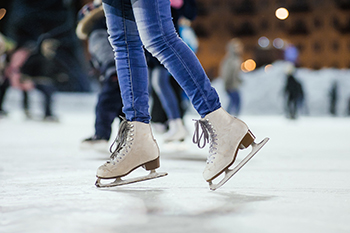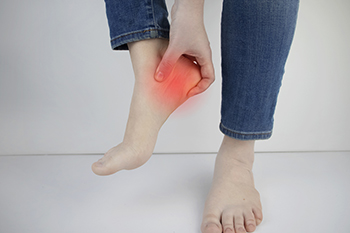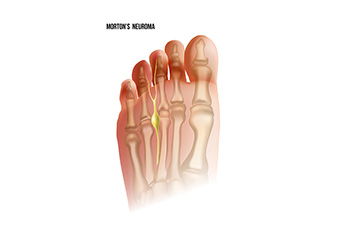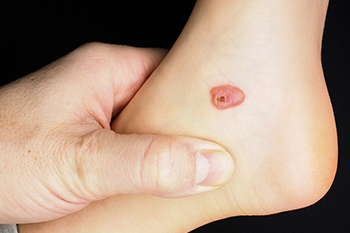Items filtered by date: July 2024
Common Foot Injuries Among Skaters

Skaters often encounter various foot injuries due to the rigorous demands placed on their feet. Wearing tight-fitting boots can lead to issues like lace bite, where the pressure from laces causes pain and inflammation across the top of the foot. Blisters are another common problem, caused by friction and repetitive motion in ill-fitting skates. Achilles tendon injuries are prevalent due to the intense strain during jumps and spins, resulting in pain and stiffness in the back of the ankle. Additionally, skaters may develop malleolar bursitis, inflammation of the fluid-filled sacs around the ankle bones, from constant rubbing against skate boots. Understanding these injuries is essential for skaters to adjust their equipment and practice proper stretching and strengthening exercises. If you enjoy skating and have incurred a foot or ankle injury, it is suggested that you contact a podiatrist who can treat any foot condition, and guide you on additional injury prevention techniques.
Foot Pain
Foot pain can be extremely painful and debilitating. If you have a foot pain, consult with Deborah Rosenfeld from Rosenfeld Podiatry. Our doctor will assess your condition and provide you with quality foot and ankle treatment.
Causes
Foot pain is a very broad condition that could be caused by one or more ailments. The most common include:
- Bunions
- Hammertoes
- Plantar Fasciitis
- Bone Spurs
- Corns
- Tarsal Tunnel Syndrome
- Ingrown Toenails
- Arthritis (such as Gout, Rheumatoid, and Osteoarthritis)
- Flat Feet
- Injury (from stress fractures, broken toe, foot, ankle, Achilles tendon ruptures, and sprains)
- And more
Diagnosis
To figure out the cause of foot pain, podiatrists utilize several different methods. This can range from simple visual inspections and sensation tests to X-rays and MRI scans. Prior medical history, family medical history, and any recent physical traumatic events will all be taken into consideration for a proper diagnosis.
Treatment
Treatment depends upon the cause of the foot pain. Whether it is resting, staying off the foot, or having surgery; podiatrists have a number of treatment options available for foot pain.
If you have any questions, please feel free to contact our office located in Marlton, NJ . We offer the newest diagnostic and treatment technologies for all your foot care needs.
Causes and Relief From Plantar Fasciitis

Plantar fasciitis is a common condition characterized by inflammation of the plantar fascia, a thick band of tissue that runs along the bottom of the foot. Symptoms often include sharp heel pain, especially in the morning or after long periods of rest. Causes of plantar fasciitis can vary, with overpronation, where the foot rolls inward excessively, being a significant factor. Additionally, differences in leg length can contribute to uneven stress on the feet. Relief options are available, including stretching exercises, orthotic supports, and proper footwear. Using anti-inflammatory medications can also help alleviate pain. If you have heel pain, it is strongly suggested that you consult a podiatrist who can successfully treat plantar fasciitis.
Plantar fasciitis is a common foot condition that is often caused by a strain injury. If you are experiencing heel pain or symptoms of plantar fasciitis, contact Deborah Rosenfeld from Rosenfeld Podiatry. Our doctor can provide the care you need to keep you pain-free and on your feet.
What Is Plantar Fasciitis?
Plantar fasciitis is one of the most common causes of heel pain. The plantar fascia is a ligament that connects your heel to the front of your foot. When this ligament becomes inflamed, plantar fasciitis is the result. If you have plantar fasciitis you will have a stabbing pain that usually occurs with your first steps in the morning. As the day progresses and you walk around more, this pain will start to disappear, but it will return after long periods of standing or sitting.
What Causes Plantar Fasciitis?
- Excessive running
- Having high arches in your feet
- Other foot issues such as flat feet
- Pregnancy (due to the sudden weight gain)
- Being on your feet very often
There are some risk factors that may make you more likely to develop plantar fasciitis compared to others. The condition most commonly affects adults between the ages of 40 and 60. It also tends to affect people who are obese because the extra pounds result in extra stress being placed on the plantar fascia.
Prevention
- Take good care of your feet – Wear shoes that have good arch support and heel cushioning.
- Maintain a healthy weight
- If you are a runner, alternate running with other sports that won’t cause heel pain
There are a variety of treatment options available for plantar fasciitis along with the pain that accompanies it. Additionally, physical therapy is a very important component in the treatment process. It is important that you meet with your podiatrist to determine which treatment option is best for you.
If you have any questions, please feel free to contact our office located in Marlton, NJ . We offer the newest diagnostic and treatment technologies for all your foot care needs.
Facts About Morton's Neuroma

Morton's neuroma is a painful condition affecting the ball of the foot, most commonly between the third and fourth toes. It involves the thickening of tissue surrounding one of the nerves leading to the toes, causing sharp, burning pain or a feeling of something being stuck inside the ball of the foot. Contributing factors include wearing high heels or tight shoes, which put pressure on the toes and the nerves. Symptoms can also include numbness or a tingling sensation in the toes. Relief methods include wearing wider shoes with lower heels, using arch supports or foot pads, and resting the feet to reduce pressure. In more severe cases, medical treatments such as corticosteroid injections or surgery may be necessary. If pain has developed in this part of your foot, it is suggested that you visit a podiatrist who can provide a proper diagnosis and treatment.
Morton’s neuroma is a very uncomfortable condition to live with. If you think you have Morton’s neuroma, contact Deborah Rosenfeld of Rosenfeld Podiatry. Our doctor will attend to all of your foot care needs and answer any of your related questions.
Morton’s Neuroma
Morton's neuroma is a painful foot condition that commonly affects the areas between the second and third or third and fourth toe, although other areas of the foot are also susceptible. Morton’s neuroma is caused by an inflamed nerve in the foot that is being squeezed and aggravated by surrounding bones.
What Increases the Chances of Having Morton’s Neuroma?
- Ill-fitting high heels or shoes that add pressure to the toe or foot
- Jogging, running or any sport that involves constant impact to the foot
- Flat feet, bunions, and any other foot deformities
Morton’s neuroma is a very treatable condition. Orthotics and shoe inserts can often be used to alleviate the pain on the forefront of the feet. In more severe cases, corticosteroids can also be prescribed. In order to figure out the best treatment for your neuroma, it’s recommended to seek the care of a podiatrist who can diagnose your condition and provide different treatment options.
If you have any questions, please feel free to contact our office located in Marlton, NJ . We offer the newest diagnostic and treatment technologies for all your foot care needs.
What Are the Causes of Foot Blisters?

Foot blisters are a common and painful issue caused by various factors. Friction is the primary culprit, often resulting from poorly fitting shoes that rub against the skin. Excessive moisture from sweat can soften the skin, making it more prone to blistering. Prolonged activity, such as running or hiking, increases the likelihood of blisters due to continuous friction and pressure. Heat and humidity exacerbate the problem, as damp skin is more susceptible to damage. Additionally, wearing socks that do not wick away moisture or that bunch up can also contribute to blister formation. Understanding these causes helps in taking preventive measures, such as choosing well-fitted, breathable footwear and moisture-wicking socks. Foot blisters can be common, and may become infected if not cared for properly. If this applies to you, it is suggested that you contact a podiatrist who can offer effective treatment solutions for infected blisters.
Blisters are prone to making everyday activities extremely uncomfortable. If your feet are hurting, contact Deborah Rosenfeld of Rosenfeld Podiatry. Our doctor can provide the care you need to keep you pain-free and on your feet.
Foot Blisters
Foot blisters develop as a result of constantly wearing tight or ill-fitting footwear. This happens due to the constant rubbing from the shoe, which can often lead to pain.
What Are Foot Blisters?
A foot blister is a small fluid-filled pocket that forms on the upper-most layer of the skin. Blisters are filled with clear fluid and can lead to blood drainage or pus if the area becomes infected.
How Do Blisters Form?
Blisters on the feet are often the result of constant friction of skin and material, usually by shoe rubbing. Walking in sandals, boots, or shoes that don’t fit properly for long periods of time can result in a blister. Having consistent foot moisture and humidity can easily lead to blister formation.
Prevention & Treatment
It is important to properly care for the affected area in order to prevent infection and ease the pain. Do not lance the blister and use a Band-Aid to provide pain relief. Also, be sure to keep your feet dry and wear proper fitting shoes. If you see blood or pus in a blister, seek assistance from a podiatrist.
If you have any questions, please feel free to contact our office located in Marlton, NJ . We offer the newest diagnostic and treatment technologies for all your foot care needs.
Get Professional Care for a Broken Foot or Ankle
The Importance of Ankle-Foot Orthosis for Various Ankle Issues

Ankle-foot orthosis, or AFO, is the most commonly prescribed orthosis for individuals with foot drop and various ankle and foot problems. This medical device supports the foot and ankle, improving stability and mobility. Made from lightweight, durable materials such as plastic, carbon fiber, or a combination, AFOs provide a custom fit tailored to the patient's specific needs. They function by holding the foot in a fixed position, preventing it from dragging while walking, thereby reducing the risk of tripping. AFOs are essential for individuals with conditions like a stroke, multiple sclerosis, cerebral palsy, and other neurological disorders that cause muscle weakness. By offering essential support and enhancing gait, AFOs significantly improve the quality of life for those with foot drop and related ankle and foot issues. If you have a specific ankle condition, it is suggested that you consult a podiatrist who can determine if an ankle-foot orthosis is the right choice for you.
If you are having discomfort in your feet and would like to try orthotics, contact Deborah Rosenfeld from Rosenfeld Podiatry. Our doctor can provide the care you need to keep you pain-free and on your feet.
What Are Orthotics?
Orthotics are inserts you can place into your shoes to help with a variety of foot problems such as flat feet or foot pain. Orthotics provide relief and comfort for minor foot and heel pain but can’t correct serious biomechanical problems in your feet.
Over-the-Counter Inserts
Orthotics come in a wide variety of over-the-counter inserts that are used to treat foot pain, heel pain, and minor problems. For example, arch supports can be inserted into your shoes to help correct overarched or flat feet, while gel insoles are often used because they provide comfort and relief from foot and heel pain by alleviating pressure.
Prescription Orthotics
If over-the-counter inserts don’t work for you or if you have a more severe foot concern, it is possible to have your podiatrist prescribe custom orthotics. These high-quality inserts are designed to treat problems such as abnormal motion, plantar fasciitis, and severe forms of heel pain. They can even be used to help patients suffering from diabetes by treating foot ulcers and painful calluses and are usually molded to your feet individually, which allows them to provide full support and comfort.
If you are experiencing minor to severe foot or heel pain, it’s recommended to speak with your podiatrist about the possibilities of using orthotics. A podiatrist can determine which type of orthotic is right for you and allow you to take the first steps towards being pain-free.
If you have any questions please contact our office located in Marlton, NJ . We offer the newest diagnostic and treatment technologies for all your foot and ankle needs.


